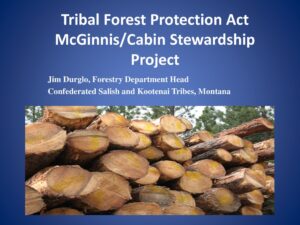
The Tribal Forest Protection Act (TFPA) of 2004 was a landmark piece of legislation aimed at empowering Native American tribes to manage and protect forested lands. One of the key aspects of this act is its emphasis on enhancing Community Wildfire Protection Plans (CWPPs). This article explores how the TFPA supports CWPPs, the benefits of these plans, and the impact on tribal and adjacent communities.
Understanding the Tribal Forest Protection Act of 2004
The TFPA was enacted in response to the increasing threat of wildfires and the need for effective forest management on tribal lands. This act allows tribes to propose projects on Forest Service or Bureau of Land Management lands that border or are adjacent to Indian trust lands. The primary objective is to reduce the risk of wildfires and promote healthier forest ecosystems.
Key Provisions of the TFPA
- Tribal Involvement: The act encourages tribes to take an active role in forest management, recognizing their traditional knowledge and expertise.
- Collaborative Projects: Tribes can propose forest management projects that involve thinning, controlled burns, and other wildfire risk reduction strategies.
- Federal Support: The act mandates that federal agencies work closely with tribes to implement these projects, providing necessary technical and financial support.
The Role of Community Wildfire Protection Plans (CWPPs)
Community Wildfire Protection Plans are strategic plans that address wildfire risks in a specific area. They involve collaboration among local communities, government agencies, and other stakeholders. CWPPs aim to reduce wildfire risks through various measures such as fuel reduction, public education, and emergency preparedness.
How the TFPA Enhances CWPPs
The TFPA enhances CWPPs by:
- Empowering Tribal Communities: By involving tribes in the development and implementation of CWPPs, the TFPA ensures that tribal perspectives and traditional ecological knowledge are integrated into wildfire management strategies.
- Facilitating Collaboration: The act fosters collaboration between tribes and federal agencies, ensuring that resources are pooled and efforts are coordinated for maximum effectiveness.
- Funding and Resources: The TFPA provides a framework for securing funding and technical assistance, making it easier for tribal communities to implement CWPPs.
Benefits of Enhanced CWPPs

Enhanced CWPPs offer numerous benefits to both tribal and adjacent communities:
- Reduced Wildfire Risk: By implementing effective fuel reduction strategies, CWPPs significantly lower the risk of catastrophic wildfires.
- Healthier Forest Ecosystems: Proper forest management practices promote healthier forests, which are more resilient to pests, diseases, and climate change.
- Economic Opportunities: Forest management projects can create jobs and stimulate economic growth in tribal communities.
- Cultural Preservation: Integrating traditional ecological knowledge helps preserve cultural practices and ensures that forest management respects tribal heritage.
Case Studies: Successful Implementation of the TFPA and CWPPs
The White Mountain Apache Tribe
The White Mountain Apache Tribe in Arizona has successfully utilized the TFPA to enhance their CWPP. By collaborating with the Forest Service, they implemented a series of controlled burns and thinning projects that have significantly reduced wildfire risks. This partnership has also led to the restoration of culturally significant forest areas, benefiting both the environment and the tribe’s cultural heritage.
The Confederated Salish and Kootenai Tribes
In Montana, the Confederated Salish and Kootenai Tribes have been proactive in developing CWPPs under the TFPA. Their projects have focused on creating defensible spaces around communities, improving forest health, and educating the public about wildfire risks. These efforts have not only protected tribal lands but also improved safety for neighboring non-tribal communities.
Challenges and Future Directions
While the TFPA has been instrumental in enhancing CWPPs, there are still challenges to overcome:
- Funding Limitations: Securing adequate funding for large-scale projects remains a challenge for many tribes.
- Interagency Coordination: Ensuring seamless collaboration between multiple agencies can be complex and time-consuming.
- Climate Change: As climate change continues to exacerbate wildfire risks, there is a need for adaptive management strategies that can address these evolving challenges.
Future Directions
To further enhance the effectiveness of CWPPs under the TFPA, future efforts should focus on:
- Increased Funding: Advocating for increased federal and state funding to support tribal forest management projects.
- Research and Innovation: Investing in research to develop innovative wildfire management techniques and adaptive strategies.
- Strengthened Partnerships: Building stronger partnerships between tribes, federal agencies, and local communities to foster a collaborative approach to wildfire management.
Conclusion
The Tribal Forest Protection Act of 2004 has played a crucial role in enhancing Community Wildfire Protection Plans. By empowering tribal communities, facilitating collaboration, and providing necessary resources, the TFPA has helped reduce wildfire risks and promote healthier forest ecosystems. Continued support and innovation in this area are essential to address the growing threat of wildfires and ensure the protection of tribal and adjacent communities.


